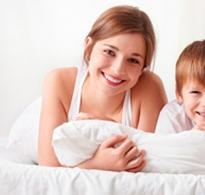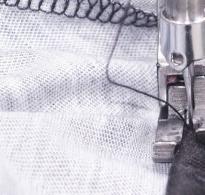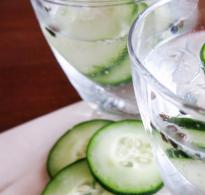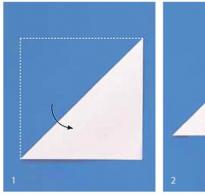"Pets". Summary of GCD in the nursery group. Summary of an open lesson for a nursery group “Wonderful fish” Summary of a lesson in a nursery
Summary of direct educational activities in the early age group
Target: teach children to select objects based on color, by display and by verbal designation “like this.”Tasks:
Educational:
Strengthen in children the ability to correlate objects by color, shape, weight, and touch;
Continue introducing children to geometric shapes (circle, square, triangle);
Encourage children to name objects and their properties (“heavy” - “light”, “prickly” - “fluffy”).
Educational:
To develop children's attention and mental operations;
Foster independence and active actions;
Expand the experience of orientation in the environment, enriching children with a variety of sensory representations.
Educational:
Cultivate in children a friendly attitude, a desire to help, to come to the rescue.
Preliminary work: examination, comparison. Didactic games: “Hide the mouse from the cat”, “Arrange by color (shape)”.
Didactic materials and equipment: a plush bunny, a prickly hedgehog, geometric shapes of different colors, a didactic game “Hide the Bunny”, handbags – light and heavy, “stumps”.
Participants: children from the nursery group, teacher. 1. Introductory part
Educator:
-Guys, look how many guests came to our group! Let's greet the guests and smile at them.
Children say hello.
Educator:
Guys, look, we have another guest. This is Hedgehog. Let's say hello to him too.
(Children greet the hedgehog, children look at it, touch it with their hands. What kind of Hedgehog? - “spiky”)
Educator:
Guys, Hedgehog says that he came to visit to play with the guys. Do you want to play with the Hedgehog? (we look at the stumps, determine the shape)
The hedgehog brought us different figures and asked us to find our own house for these figures. We take the circle and put it in the same round house, we take the figures one at a time!
Well done boys! All the figures are in their own houses. And the hedgehog is very happy! Now let's say goodbye to the hedgehog!
(Children say goodbye to Hedgehog)
- Look who is sitting under this tree?
- It's a bunny! (they examine and stroke how fluffy it is, but how prickly the hedgehog was)
- Guys, he’s cold, he’s shaking all over. Let's help him warm up.
Physical education lesson “The little white bunny is sitting.”
White bunny sitting
And he wiggles his ears.
Like this, like this
He wiggles his ears.
They move their hands, raising them to the head.
It's cold for the bunny to sit -
We need to warm our paws,
Clap, clap, clap, clap,
We need to warm our paws.
They clap their hands.
It's cold for the bunny to stand
The bunny needs to jump.
Skok-skok, skok-skok,
The bunny needs to jump.
Bounce on both legs in place.
The wolf scared the bunny
The bunny jumped and galloped away.
Guys, the bunny warmed up and said that the gray wolf wanted to catch the little bunnies. Let's help the bunnies hide from the wolf.
Didactic game “Hide the Bunnies”
(Children, sitting at tables, complete the task individually.)

Did we help the bunnies hide from the evil wolf?
Children:- Yes!
- Guys, you are so great! How much good and kindness we have done with you. You helped both the hedgehog and the bunny, for which they also sent you gifts! These are the kind of handbags - some are compared as “light”, others as “heavy”.
- Do you want to see what is in these heavy bags? (there are bags of sand at the bottom, and apples on top - treats)
We open our bags and help ourselves.
UDC 373.23
B B K 74.102
K26 N. A. Karpukhina
Lesson notes for the nursery group of a kindergarten. Practical guide for educators and methodologists of preschool educational institutions. - Voronezh:
IP Lakotsenin S. S., 2010 - 208 p.
ISBN 978-5-98225-086-5
The proposed lesson notes are recommended for use
for work on the programs “Education and training of children in kindergarten”
(Vasilieva M.A., new edition), “Childhood” (Russian State Pedagogical University named after Herzen), “Development
(team of authors led by L.A. Wenger), etc.
The book is recommended for use by methodologists and educators.
kindergarten students, parents and tutors.
ISBN 978-5-98225-086-5 Г^^ло "
B B K 74.102
Other publications of this publication in any form,
in whole or in parts, are illegal
and are prosecuted
© Karpukhina N. A., author, 2010
© IP Lakotsenin S. S., publisher, 2010
Signed for publication on 08/25/10. Newsprint paper. Format 60x84 1/16. Printing of-
net Volume 13 p.l. Circulation 5,000 copies. Order No. 3745.
Editor-in-chief S. S. Lakotsenin. Executive editor Yu. A. Krapivin.
Proofreader A. N. Taltynova. Layout by A. Naydenov
IP Lakotsenin S.S.: Voronezh, st. South Moravian, 156
Printed by the OJSC Order of the Badge of Honor "Smolensk Regional Printing House"
named after V.I. Smirnov." 214000, Smolensk, prospect. Yu. Gagarina, 2.
Preface 3
Preface
A newborn is a mystery. Nobody
doesn't know what will come of it. He can
become a genius and enrich the world if for
favorable conditions will be created for him
viya. But all the promising makings
will remain in vain if parents, educated
tel, doctors will not help to open them.
Look for a friend in your child, learn
put his interests above all else.
Because in the end everything is best
in life is done for the child.
Professor M. Korshunov
During the 2nd year of life, significant changes occur in the child’s body, both in physical and neuropsychic development. .
The most characteristic features of the behavior of a child of this age are high motor activity, emotionality, great interest in the environment, a great need for frequent communication with adults and high learning ability.
How a child will develop when he gets older, what his relationships with people around him will be, largely depends on whether adults will have to develop and continue what has already been brought up in the baby, or whether there is a need to re-educate and change unwanted forms of behavior.
Early age is literally Start. The child is just entering the world of relationships, he is inexperienced and very trusting.
Our task is to help him maintain this trust, to fall in love with those who tirelessly care for him, to create a cheerful, cheerful mood - all this is necessary for comprehensive and harmonious development in subsequent years. At the age of up to 2 years, the state of his health is decisive for the correct, comprehensive development of the child.
A healthy child, if he is raised correctly, is emotional, eats with appetite, and is active. To do this, it is necessary to create in the child, as A.S. Makarenko said, “a habit of a certain hour,” i.e. correctly organize the daily routine - play activities, sleep, nutrition, walking, targeted activities should replace each other in the most appropriate sequence.
Preface 4
The daily routine organizes children's behavior, creates a feeling of well-being in children, and introduces rhythm into the functioning of the nervous system.
When it is performed, conditioned reflexes are developed for a while.
Thanks to this, the body is, as it were, prepared in advance for this or that activity. Proper implementation of routine processes is a necessary condition not only for the full physical development of children, but also for their cheerful mood, good appetite, and restful and deep sleep.
When carrying out regime processes, it is necessary to comply with the principle sequences And gradualism.
Principle sequences The idea is that adults should instill in children from early childhood the skill of performing certain actions in a certain order. For example, before going to bed, you need to collect all the toys, before eating, be sure to wash your hands, etc.
Principle gradualism consists of gradually involving children in small groups in performing one or another routine process; the younger the child, the smaller the group. This is explained by the physiological characteristics of children of the 2nd year of life: they do not know how to wait for a long time, they begin to be capricious if crowding appears, and they quickly get tired of the monotony of actions.
In implementing the principles sequence and post-
foaminess Certain rules must be followed:
1. Each of the regime processes must pass only
in the background of the game.
2. When conducting regime processes, it is necessary to use an individual-personal model of education.
3. Implementation of the principles sequence and gradual
ness provides for the unity of requirements on the part of adults both in a preschool institution and at home.
The methodology for conducting regime processes involves the use of mandatory techniques:
1. Creating a pre-set in children for this
process.
2. The implementation of one or another regime process must
proceed without fuss, without causing discomfort to the kids.
3. When carrying out any regime process in a child,
cannot build confidence that everything will work out, he will be able to
t.thick. action to the end, if he tries.
Types of activities
Quantity
1.
Expansion of orientation in the surrounding world and development of speech
3 2. Speech development
2 3. Classes with didactic material
2 4. Exercises with building materials
1 5. Musical lesson
2
Total
10
Duration of classes is 10-15 minutes, with a subgroup of children of 8-12 people.
For all types of activities, approximate long-term plans and lesson notes for the year are presented.
Preface 5
4. An adult should definitely rejoice in the success of the kids and
Praise them more often for any new achievements.
In order to systematically influence the comprehensive development of children at this age, special classes are held in which children are taught to listen, monitor what the adult is doing and showing, and are encouraged to imitate his words and actions, and carry out the teacher’s tasks.
We present to your attention a list of basic activities for children of the second year of life according to Education, training and
development in kindergarten under the new edition of V.M. Vasilyeva.
,10 The child and the world around him
Child and the world around
for children 2 years of age
September
1. “Visiting children” phenomena of social life:
family, culture of behavior
2. “Okay, okay” inanimate nature: sand properties
3. “Leaves are falling” living nature:
vegetable world
4. “Our toys” object world:
toys - color, shape
October
5. “The path to the bunny’s phenomenon of social life: the hut” city
6. “Cockerel cockerel” inanimate nature: Sun
7. “Wonderful bag” wildlife: vegetables fruits
8. “Who lives next to us? » subject world:
purpose of objects
November
9. “Who lives in the house? » phenomena of social life:
family
10. “Hummocks, hummocks, smooth inanimate nature: the soil
track"
11. “To the forest to see friends!” Live nature: wild animals
12. “Room for Katya” object world:
furniture - name, color
December
13. “On the path into the winter forest” phenomena of social life:
city.
14. “Doll Katya is walking” inanimate nature:
seasons - winter
15. “Our true friends” wildlife: winter quarters for animals
16. “Toys in places” object world:
purpose of objects
Long-term planning for the year 7
January
17. “How we play together” phenomena of social life:
family
18. “Snowflakes are flying” inanimate nature: properties of snow
19. “Little Christmas tree” wildlife:
evergreen herringbone
20. “Masha the Confused” object world: cloth
February
21. “Capricious Bear” phenomena of social life:
culture of behavior
22. “The doll is cold!” inanimate nature: signs of winter
23. “Teddy bear on the hill” wildlife:
plants, animals
24. “What will you drive?” subject world: transport
March
25. “What will we give Tanya? » phenomena of social life:
family
26. “Let’s dress Katya for a walk” inanimate nature:
seasons - spring
27. “Where is my mom?” Live nature:
animals and their babies
28. “Let’s feed Katya” subject block: dishes
April
29. “We are mother’s helpers” phenomenon of social life:
family
30. “Come out, my friend, wildlife: plants
to the green meadow"
31. “Yellow, fluffy” wildlife: poultry
32. “Toys for Misha, object world: toys
and Mishutki"
May
In May, classes can be held to consolidate children’s knowledge about the world around them, practicing the skills of observation, research, and curiosity.
,10 The child and the world around him
Child and the world around
Lesson cycle
September
Lesson No. 1
Visiting the children
Program content: Introduce children to the basic ethics of greeting, develop communication skills in relation to adults and peers, and develop cultural communication skills.
Material: screen; doll, bear, bunny, dog - toys.
Progress of the lesson
The teacher draws the children’s attention to the weather outside the window: leaves are falling, children are going to kindergarten. There is a knock on the door, a Tanya doll appears from behind the screen and conducts a dialogue with the teacher:
- I am the doll Tanya. I came to the kids. I want to say hello to them
(greets the children and gives them green leaves).
The teacher invites all children to greet them.
Then another knock is heard and other toys appear one by one from behind the screen: a bear, a bunny, a dog. They don't know where they are and don't know how to say hello.
The teacher explains to the toys where they ended up and invites the children to teach the animals to say hello. The animals thank the children and give them leaves: red, yellow.
At the end of the lesson, the teacher draws attention to the fact that many guests have come to them and calls them: Tanya doll, bear, bunny, dog. They all look at the leaves together and say: “Autumn has come. The leaves are falling. The leaves are different - yellow and red."
Lesson No. 2
Okay, okay
Program content: To acquaint children with the properties of sand, develop attentiveness and finger motor skills, cultivate accuracy and mutual assistance during the game.
September 9
Material: molds for sand, container with water, sand, planks, Tanya doll.
Progress of the lesson
The teacher draws the children’s attention to the fact that the doll Tanya will soon come to visit, she needs to be treated to pies and offers to prepare pies.
The children sit in a semicircle on chairs, the teacher takes sand and sand molds and tries to make a pie, but the pie doesn’t work, the sand crumbles. He takes water, pours sand, the children examine the wet sand and possible options for making pies from different molds.
The teacher explains why the pies are made. Next, he invites the children to make their own pie using molds from the sand set.
Oh, okay, okay,
Let's bake pancakes
We will invite Tanyusha,
We'll treat you to some pies.
The Tanya doll comes in, examines the prepared pies, and thanks the children.
Lesson No. 3
Leaves are falling
Program content: Introduce children to the colors of autumn leaves, compare leaves by size: large, small, cultivate a love of nature, develop cognitive interest.
Material: autumn leaves: green, yellow, red - large and small.
Progress of the lesson
The teacher suggests approaching the carpet, on which there is a basket with leaves of different colors and sizes. Children look at colored leaves with the teacher: red, yellow and green.
,10 The child and the world around him
Then it is carried out outdoor game “Leaves are falling”- children spin around with the leaves to the music, and at the teacher’s signal they squat with the leaves.
The teacher asks the children questions:
- What kind of leaf do you have, yellow? (yellow leaf)
- What kind of leaf do you have, red? (red)
At the end of the lesson, children lay out an autumn pattern on the carpet
- a large and a small leaf and once again admire and examine the leaves.
Lesson No. 4
Our toys
Program content: Help to find toys, identify them by size, name them, develop spatial orientation, and develop forms of careful handling of toys.
Material: set of toys: bear - big and small, bunny - big and small.
Progress of the lesson
The teacher draws the children’s attention to the sounds of an approaching car; a large car with a large bear drives in.
The teacher says:
- Look who came to us? (bear)
- What a big bear, he wants to play with the little bear, let's help him find it.
Together with the children they find a teddy bear in the group room. Held outdoor game “Find the bear”. Work with large and small bunnies is carried out in the same way. Children find a little bunny.
At the end of the lesson, an active game is played, where the teacher puts “bear” and “bunny” hats on two children, all the children dance and jump to a tambourine, start to run away at a signal, and the “bunny” and “bear” catch up with them. The role of a “bunny” or “bear” can be played by a teacher.
September 11
October
Lesson No. 5
Path to the bunny's hut
Program content: To promote the development of visual perception of a moving object, coordination of movements, give the concept and name “Path to the hut.” Cultivate accuracy when performing a task.
Material: bricks of the same color, a bunny toy, Christmas trees, trees, a house from a tabletop theater.
Progress of the lesson
The teacher draws the children’s attention to a forest clearing with a hut, the children look at it: “So many fir trees and trees, but here is a hut. Who lives in this hut? A little bunny appears and cries bitterly; he does not know how to get to his hut in the forest. The teacher invites the children to help the bunny build a path to the hut out of bricks. Together with the teacher, the children lay out a path of bricks towards the hut. Then the teacher invites the children to lead the bunny along the path to the hut, saying: “top-top.”
IN At the end of the lesson, the bunny thanks the children and under-
visual game “Bunny, dance.” Children dance and jump to the tambourine with the bunny.
Lesson No. 6
Cockerel cockerel
Program content: Introduce children to time concepts: morning, develop imaginative thinking. Develop cultural and hygienic skills.
Material: Tanya doll; a crib, a comb, a towel, soap, a basin of water, a toy cockerel.
Progress of the lesson
The teacher and children examine the crib and the sleeping doll
Tanya. The voice of a cockerel is heard: “Ku-ka-re-ku!” The teacher conducts a dialogue with the cockerel:
IN
,10 The child and the world around him
Cockerel, cockerel!
Golden comb!
Oil head,
Silk beard,
Why do you get up early?
Don't you let Katya sleep?
The cockerel answers:
It's time for everyone to get up
And Tanechka and Vanechka,
And to all the kids!
The teacher and the children lift the Tanya doll, dress her, comb her hair, and wash her. Tanya says to everyone: “Good morning!”
At the end of the lesson, the children play with the Tanya doll and the cockerel, and the teacher reminds that the cockerel wakes up all the children in the morning, all the children get up and say: “Good morning!” The cockerel leaves and says to all the children: “Goodbye.”
Lesson No. 7
Wonderful pouch
Program content: To consolidate children’s knowledge in naming fruits: pear, apple, banana; recognize them in the picture.
Cultivate a love for nature.
Material: replicas of fruits: pear, apple, banana; wonderful bag, Tanya doll, cut cards with images of fruits
(2 parts).
Progress of the lesson
The teacher and children look at the nature of autumn through the window: leaves are falling, the breeze is blowing, children are dressed in jackets, coats, hats, boots. There is a knock on the door, and a Tanya doll comes in with a wonderful bag containing fruit. The children greet the doll and the a game
"Guess what it is?" Doll Tanya takes out an apple and asks the children: “What is this? “If the children find it difficult to name, the teacher helps them.
- Apple.
- Is the apple red? (red)
- And what's that? (pear)
September 13
- Is the pear green? (green)
- And what's that? (banana)
- Is the banana yellow? (yellow)
IN at the end of the lesson didactic game “Collect cards”
teen." Children first collect a picture following the example of the teacher, then independently.
Lesson No. 8
Who lives next to us?
Program content: To develop in the child the skill of correlating his actions with a simple (consisting of one task) verbal instruction, not supported by a gesture or other auxiliary means, to give an idea of how a chicken moves and pecks grains. Cultivate care for others and love for animals.
Natalia Syomina
Methodical manual “Developmental activities for the nursery group.”
What childhood age requires the greatest attention to itself in terms of the opportunities provided to accelerate mental child development, the use or non-use of which can have serious consequences? From a psychological and pedagogical point of view, this is early childhood age from one to three years. This age is one of the key ones in a child’s life and largely determines his psychological future. development. The special significance of this age is explained by the fact that it is directly related to three fundamental life acquisitions baby: upright posture, verbal communication and objective activities. But the main thing is that at this age the child masters a skill that significantly affects his subsequent behavioral, intellectual and personal development. development, namely, ability understand and actively use language in communication with people. Through the speech that the child masters during these years, he gains direct access to the most important achievements of human material and spiritual culture. And the process development speech is integrally connected with development fine motor skills of the hand. Developing fine motor skills of the hands, we simultaneously have a beneficial effect on child's intelligence development. That is why special attention to classes should be devoted to productive activities.
In the second year of life, the child reproduces the actions of adults with objects, and he develops object-based imitation games. They represent the first steps towards symbolization associated with the assimilation of norms and forms of behavior of adults, and then with the formation of certain personal qualities in the child. Later, a role-playing game appears in which the child copies ways people handling objects and communicating with each other in various situations. During the game, the child will create life stereotypes for himself, which will guide him in adulthood.
I suggest educational activities for kindergarten children(1.5-2 years). Classes are held in a group numbering 5-8 people. Young child "works to imitate", that is development from age 1.5 to 3 years is most active if there is an adult nearby doing everything together with the child. The baby feels comfortable, protected and at the same time receives new information that an adult helps him to learn. Therefore, the psychologist must take an active part in class: crawl together on the rug, build towers, dance, feed dolls, sing. Ability to imitation is the basis of motor and intellectual child development.
primary goal classes – full development young child using the experience of folk pedagogy and modern pedagogical techniques.
On classes the following are decided tasks:
Formation of correct speech
Development of thinking
Development ability to concentrate and maintain attention
Deepening knowledge about the world around us
Children's health
Development motor activity
Development gross and fine motor skills
Awakening interest in creativity
Classes are held in the evening. Duration classes 10 minutes. Change of activity to class prevents babies from feeling tired.
Particular attention to classes is given to productive activities and finger gymnastics. After all, it is in these types of activities that fine motor skills are developed. is developing more actively.
Classes based on fairy tales "Kolobok", "Chicken Ryaba", "Turnip", "Teremok". Children come to visit the fairy tales themselves and the heroes from these fairy tales with various interesting games. Classes are held once a week. Then, within a week, the material obtained from class, is fixed: games, conversations, observations, reading fairy tales are held.
Visual material on the lesson should be bright, large and safe for children. And also durable, so that every child can personally meet the chicken Ryaba or Kolobok. Natural colors are welcome, since at this age it is necessary to give the child adequate concepts about the world around him (there are no blue cats and green bears).
When a baby comes to kindergarten, he needs to adapt to new conditions. All children experience the adaptation process differently. Therefore, in September, a psychologist observes the child’s adaptation and gets to know him.
As already mentioned, the adaptation process is different for all children. Therefore, initially it is not necessary to include all children in class. It's okay if your child watches first.
I would especially like to say about the atmosphere classes. At this age it is very clearly visible that each child is an individual. And the first commandment of a teacher-psychologist should be like the first commandment of a doctor - "do no harm". Our task is to help development this individuality, and not the desire to level it out, to make the child “like everyone else.” Therefore, our concept of discipline is very relative. We must try to ensure that children are constantly included in constructive activities, but if everyone wants to build a house, but one child does not want to. He wants to go for a ride in the car. Let him walk and ride quietly, because it won’t bother anyone.
I provide sample notes classes. Naturally, they can be adjusted depending on the characteristics of your groups.
Yakubova Yulia
Summary of the final educational activity for children of the nursery group “Let's help the bunny find a basket”
Summary of the final integrated continuing education activities for children of the nursery group on the topic: « Let's help the bunny find the basket»
Educators:
Santalieva Z.K.
Yakubova Yu. S.
Saratov 2016.
Target: 1. create a joyful mood from educational activities.
Tasks:
Developmental:
Develop the ability to listen and understand the task;
Develop attention and thinking;
Develop perception children, enrich their sensory experience;
Develop skill children create a whole image from cut parts of a picture;
Develop the plot and game concept;
Refine your accumulated knowledge about working with plasticine. Improve the ability to break off small pieces from a large piece of plasticine and roll them out in a circular motion with your palms.
Educational:
Arouse and maintain interest in gaming activities;
Cultivate a friendly attitude towards peers in joint activities;
Involve children into communication, develop speech hearing;
Develop the articulatory apparatus children;
Call children positive emotions when reading A. Barto's poems;
Material:
toys bear, bunny, truck; plasticine, napkins; cut pictures; mushrooms of different colors and baskets; basket with treats.
Progress of the lesson.
Educator: Children, look, we have guests today. They will watch how you can play and have fun; how beautiful and good you all are. Let's say hello to them!
Our smart heads
They will think a lot, cleverly.
Ears will listen
Mouth speak clearly.
Hands will clap
Feet will stomp.
The backs are straightened,
We smile at each other.
Educator: Children, do you hear someone crying? Let's see who it is.
Crying in the corner behind the screen bunny.
Educator: Bunny, why are you crying?
Squirrel: Hello! I was going to visit you, I prepared a whole basket of sweets, but lost her in the magical forest. I beg you very much, please return mine to me basket of sweets.
Educator: Children, as possible help the bunny? What can be done?
Bunny: But you just won’t get to him. You will need to complete a task at each station.
Do you agree? (Answers children.)
Then have a good trip.
Educator: And you, bunny, stay here, we will find basket and we will bring it to you.
My dear children
We'll go by train.
Hurry up,
Get into the carriages.
The time is approaching
Train departs.
First station.
There are toys on the table (bear, bunny, truck).
Educator: Children, here is the first stop.
Listen to the task. Tell a poem about each toy on the table.
(Children together with the teacher recite poems by A. Barto "Bear", "Bunny", "Truck".)
Now show me a toy that is made of plastic, rubber, wood.
Educator: Well done boys. Let's move on.
Hurry up and get into the carriages!
2 Station "Collect a picture".
There are pictures on the table
Educator: Children, here is the next task.
Let's gather our friends from the cut-up pictures bunny.
(If someone doesn’t succeed, then the teacher helps.) Discussion from anyone, what happened.
Educator: Children, let's play with you! You wake up the bunnies, and I will be the fox. While the fox is sleeping, the bunnies are walking, and when the fox is waking up, the bunnies are hiding.
Bunnies scattered across the forest lawn,
Sat down bunnies in a circle, the bunnies are digging the root,
These are the bunnies, the runaway bunnies!
Here is a fox running, a red fox
He's looking for where the bunnies are, the runaway bunnies!
Bunnies scattered across the forest lawn
These are the kind of bunnies, runaway bunnies.
Educator: Well done guys, let's move on.
3 Station "Collect by color".
Educator: Here comes the next stop. Look who's sitting there? (Squirrel) Children, the squirrel scattered the mushrooms and now cannot collect them. Let's help the squirrel? Before us are mushrooms of different colors and baskets. You need to put the mushrooms in the appropriate color cart.
Well done, you completed the task.
Chug - chug - chug.
4 Station "Modeling carrots".
There is a carrot, an apple, a cucumber, and a cube on the table.
Educator: Children, what is on the table? (answers children) Look and tell me what is superfluous here? (answers children) . Why? (answers children) What color is the cube? (answers children) . What shape? (answers children) . Now tell me what he eats bunny? (answers children) .
Let's now make carrots from plasticine for our bunny.
There is plasticine, napkins and trays for each child on the table.
Educator: Sit down at the tables. What color is the carrot? (answers children) . Now we will take orange plasticine and roll it between our palms.
Educator: Look what beautiful carrots we got! Bunny loves carrots very much, he will definitely like your carrots!
Educator: So we reached the magical forest. What trees do we see in the forest? (answers children) . How are they different from each other? (answers children) . Let's look basket under the tree, eat under the tree basket? (answers children) . Now let's look under the birch tree, did you find it?
Found it, what a great guy
Well, now it's time to go home!
Hurry up,
Get into the carriages.
The time is approaching
Train departs.
Give it away basket and carrots for bunny.
Educator: Here, bunny, we found yours cart and brought you a gift
Squirrel: Thank you, children!
What would I do without you!
And for the fact that helped me,
I'll treat you now!
Reflection
Educator: We tried very hard to help the bunny. Really, guys? now let's remember what we did today? What did you like? Or maybe there was something that you didn’t like? Well done!
And now you and I will go eat some treats and play with the bunny! Let's say goodbye to our guests.
Publications on the topic:
Summary of direct educational activities for sensory development with children of the first junior group “Let's help the bunny.” Goal: To develop in children the ability to distinguish and correctly name colors: red, yellow, green, blue. Objectives: 1. Develop the ability to distinguish.
Summary of GCD for drawing in the middle group “Let's help the bunny” Goal: to develop artistic and aesthetic taste, creative abilities. Objectives: Educational: to train children in traditional drawing.
 Abstract of the OOD on environmental education "Let's help the bunny" first junior group Goal: developing interest in natural objects, development.
Abstract of the OOD on environmental education "Let's help the bunny" first junior group Goal: developing interest in natural objects, development.
Summary of organized educational activities on FEMP for children 4–5 years old “Let's help Pinocchio find the golden key” Summary of organized educational activities on the development of elementary mathematical concepts for the middle group “Let's help Pinocchio.
Svetlana Baizan
Summary of a lesson on speech development of children in the nursery group in accordance with the Federal State Educational Standard “Visiting Mishutka”
Educator: Baizan S.V.
Chernogorsk, Republic of Khakassia.
MADOU d/s "Goldfish"
Lesson notes for the nursery group according to the Federal State Educational Standard: "IN visiting Mishutka"
Target: Create conditions for development of speech activity in children.
Tasks:
1. Contribute development of speech hearing, stimulate speech development through development fine motor skills and tactile sensations.
2. Contribute development communication skills. Involve children into communication.
3. Enrich the vocabulary with names denoting parts of the body. Learn correlate word and expressive movement.
Progress of the lesson:
Do you want to go on a trip today? How will we travel or fly?
Children go on a trip with their teacher on a steam locomotive or airplane (optional children) . Here we are. Where have we ended up? (In the forest). What animals live in the forest? Who's waiting for us behind the tree? Bear. Let's say hello to him and tell him our names. Children say hello and say their names. - Look, what does the bear have? (eyes) Do you have eyes? The bear has - (point to the nose) children offer an answer. Where is your nose? And the bear also has (pointing to ears)- we are waiting for an answer children. Where are your ears? (etc.) (children show body parts).
Teddy bear wants to play, shall we play with him?
Logorhythmic game "Bear".
A clubfooted bear is walking through the forest.
He collects cones and sings songs.
The cone bounced straight into the bear's forehead.
The bear got angry and stomped his foot!
(children perform movements in according to the text) .
Mishutka I've collected so many cones in the basket, look! (accidentally spill pine cones on the carpet). Oh! The cones all fell apart! Let's collect them so that the bear doesn't get upset about it. Take the cones and put them in the basket. What kind of bumps do we have? (answers children - hard bumps, prickly, big, small)
Let's do it for Teddy bears gift. How can we do it treat? (Answers children - honey; berry; And. etc.)
Artistic creativity. Drawing berries for Teddy Bears.
Children draw treats for Teddy Bears.
Reflection while drawing. Having flown on a trip, where did we end up? (in the forest); Who did we meet in the forest?; And what Teddy bear gave us? What will we treat him with?
Next time we'll go again guests to Mishka? (answers children)
Publications on the topic:
Summary of an open lesson for the nursery group “Wonderful Fishes” Summary of the lesson in the nursery group “Wonderful fish” Purpose: to give elementary mathematical concepts - “one”, “many”, “small”.
Summary of open direct educational activities in the 2nd junior group “Visiting Mishutka” Municipal state preschool educational institution Kindergarten No. 1 ZATO Solnechny Abstract open integrated.
 Notes on social and communicative development on the topic: “Kuzya visiting the guys” Educational area: social and communicative.
Notes on social and communicative development on the topic: “Kuzya visiting the guys” Educational area: social and communicative.






